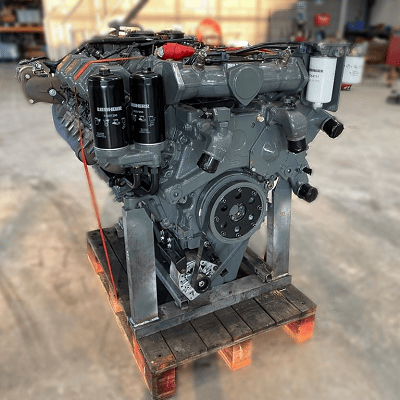The process of a dyno test on a Liebherr engine

When it comes to heavy machinery, reliability and power are paramount. Liebherr, a name synonymous with innovation and excellence in engineering, stands tall as a pioneer in the realm of heavy equipment and machinery. From towering cranes to robust excavators, Liebherr’s engineering prowess extends to the heart of these machines. We delve into the world of dyno testing a Liebherr engine, uncovering the meticulous process behind unleashing the raw power concealed within.
The foundation of excellence
Before we embark on the journey of dyno testing, it’s crucial to understand the foundation upon which Liebherr engines are built. With decades of engineering expertise and commitment to quality, Liebherr engines are crafted to withstand the most demanding environment and deliver unparalleled performance. Each component is meticulously designed and rigorously tested to ensure reliability, efficiency and longevity.
The process
1 Preparation: The engine undergoes meticulous preparation before being mounted onto the dynamo meter. This includes ensuring all connections are secure, fluids are filled to the appropriate levels, and sensors are properly calibrated.
2 Mounting: The engine is carefully mounted onto the dynamometer, a specialized device designed to simulate real-world operating conditions. Precision is paramount during this step to ensure accurate results.
3 Initial checks: Once mounted, a series of initial checks are conducted to verify proper alignment, connection integrity, and functionality of all engine systems.
4 Warm-up: The engine is started and allowed to warm up to operating temperature. This ensures consistent results and minimizes the risk of damage during testing.
5 Baseline testing: With the engine warmed up , baseline tests are conducted to establish initial performance metrics. This includes measuring power output, torque, fuel consumption, and emissions at various RPM levels.
6 Load testing: The engine is subjected to progressively increasing loads to simulate different operating conditions, such as idle, partial load and full load. This allows engineers to assess performance across the entire operating range and identify any potential issues or optimization.
7 Data analysis: Throughout the testing process, data is continuously collected and analyzed in real-time. Advanced instrumentation and software are used to monitor performance metrics and identify trends or anomalies.
8 Optimazation: Based on the data analysis, adjustments may be made to optimize engine performance. This could involve fine-tuning fuel injection timing, adjusting air-fuel ratios, or optimize turbocharger boost pressure.
9 Validation: Once testing is complete, the results are meticulously reviewed and validated against predetermined criteria and specifications. Any deviations or anomalies are thoroughly investigated to ensure accuracy and reliability.
10 Reporting: Finally, a comprehensive report is generated detailing the results of the dyno testing, including performance metrics, observations, and any recommendations for further optimization or refinement.
The outcome of dyno testing
Dyno testing a Liebherr engine is more than just a routine procedure – it’s a testament to the unwavering commitment to excellence that defines Liebherr’s engineering philosophy. By subjecting their engines to rigorous testing and analysis, Liebherr ensures that each engine delivers the uncompromising performance, reliability, and efficiency that customers expect.
In conclusion, dyno testing a Liebherr engine is not just about measuring power output. It’s about unlocking the true potential of these remarkable engines and ensuring they exceed expectations in the most challenging environments imaginable.
Regenerated Nylon 6 is also called nylon 6 recycled material, which is generally produced by melting and granulating nylon yarn, nylon yarn or nylon cloth, because nylon 6 not only has good wear resistance, heat resistance, oil resistance and chemical resistance And processability, but also has dimensional stability and excellent mechanical properties, is widely used in automotive industry parts, gears, bearings, fan blades, pump blades, fishing gear, bicycle parts and some precision engineering accessories.
3. However, nylon 6 will degrade during processing, resulting in the loss of molecular weight, affecting the melt strength and processability of the polymer, resulting in the inability of recycled or recycled materials to be used in occasions with high performance requirements, and even possible Being treated as waste is not in line with today's theme of green and low-carbon development. Therefore, how to recycle recycled nylon 6 materials to avoid resource waste and environmental pollution has become a hot research issue in recent years.
4.cn112853534a discloses a fiber manufacturing process, especially relates to a regenerated nylon 6 fiber manufacturing process, which includes the following steps: Step 1, pulverizing nylon 6 waste; Step 2, adding catalyst and ethanol and dichloroethylene A mixed solvent of alkane; Step 3, after the dissolution, filter the undissolved solids in the solution; Step 4, cool and crystallize the nylon 6 in the filtered solution at a certain temperature into a nylon 6 solid; Step 5, place the nylon 6 solid in Drying in an oven at 100-120° C. for 3-4 hours to make the water content less than 5%; Step 6, adding additives to obtain a mixture; Step 7, melt spinning to obtain regenerated nylon 6 fibers. The invention uses nylon 6 waste to produce regenerated nylon 6 fiber, which realizes the recycling of nylon 6 waste and fully avoids resource waste and environmental pollution.

Functional Nylon 6 Yarn,Uv Resistance Nylon 6 Yarn,Polyamide6 Yarn With Uv Resistance,Nylon6 Yarn For Rope
HAIYANG TECHNOLOGY CO.,LTD , https://www.hypa6.com